Annual Report
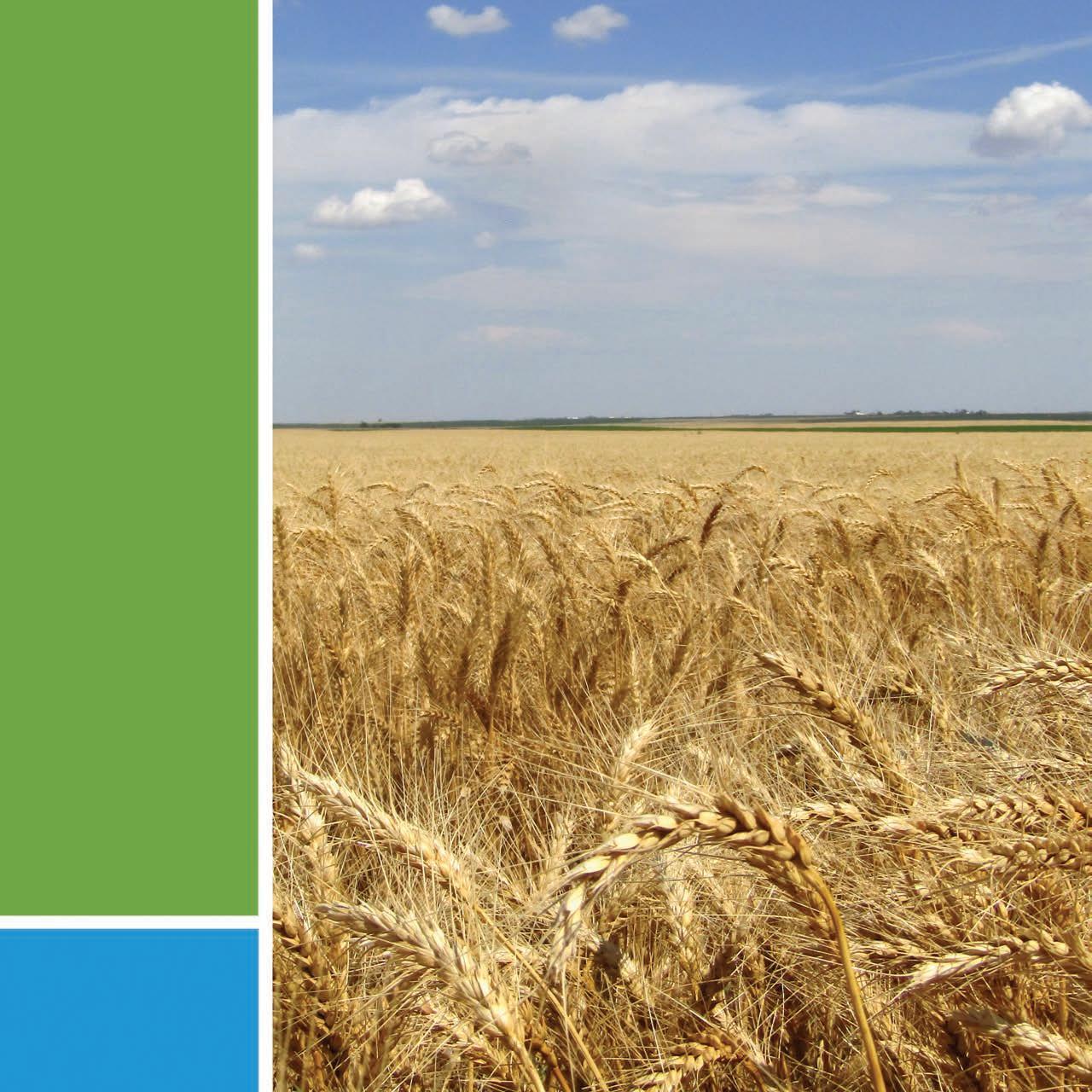
FISCAL YEAR 2021-2022
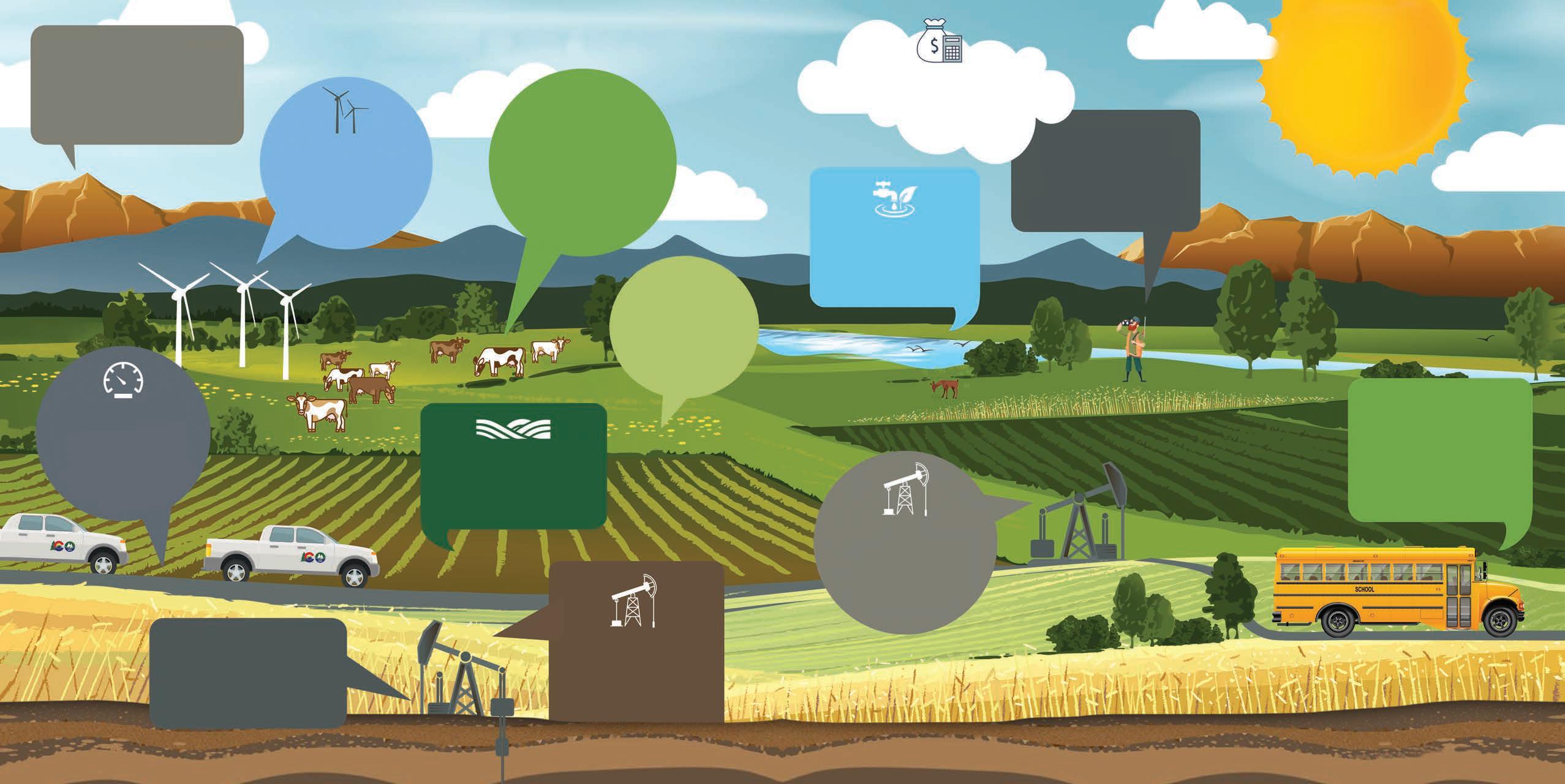
FY21-22 By the Numbers Number of 14ers located on trust land (the highest peak on trust land is 13,480 feet at Treasurevault Mountain) number of miles driven by State Land Board staff 201,357 1 st The state’s first wind turbine was on trust land Percent of trust land leased for agriculture 96 Species of rare plants that grow on trust land 52 number of acres of surface land owned 2,807,054 3 Length in miles of the longest horizontal pipe for mineral extraction # of sub-surface acres owned 4,007,726 Surface water rights 15 Gross dollars generated $246,595,709 Trust land acres enrolled in the Public Access Program 960,717 Percent of extraction leases actually drilled 12 Students who have attended BEST schools (since 2008) 325,000+ Megawatts of renewable energy generated on trust land 225 FY21-22 ANNUAL REPORT FY21-22 ANNUAL REPORT
Front cover photo: Wheat field before summer harvest on trust land in Sedgwick County.
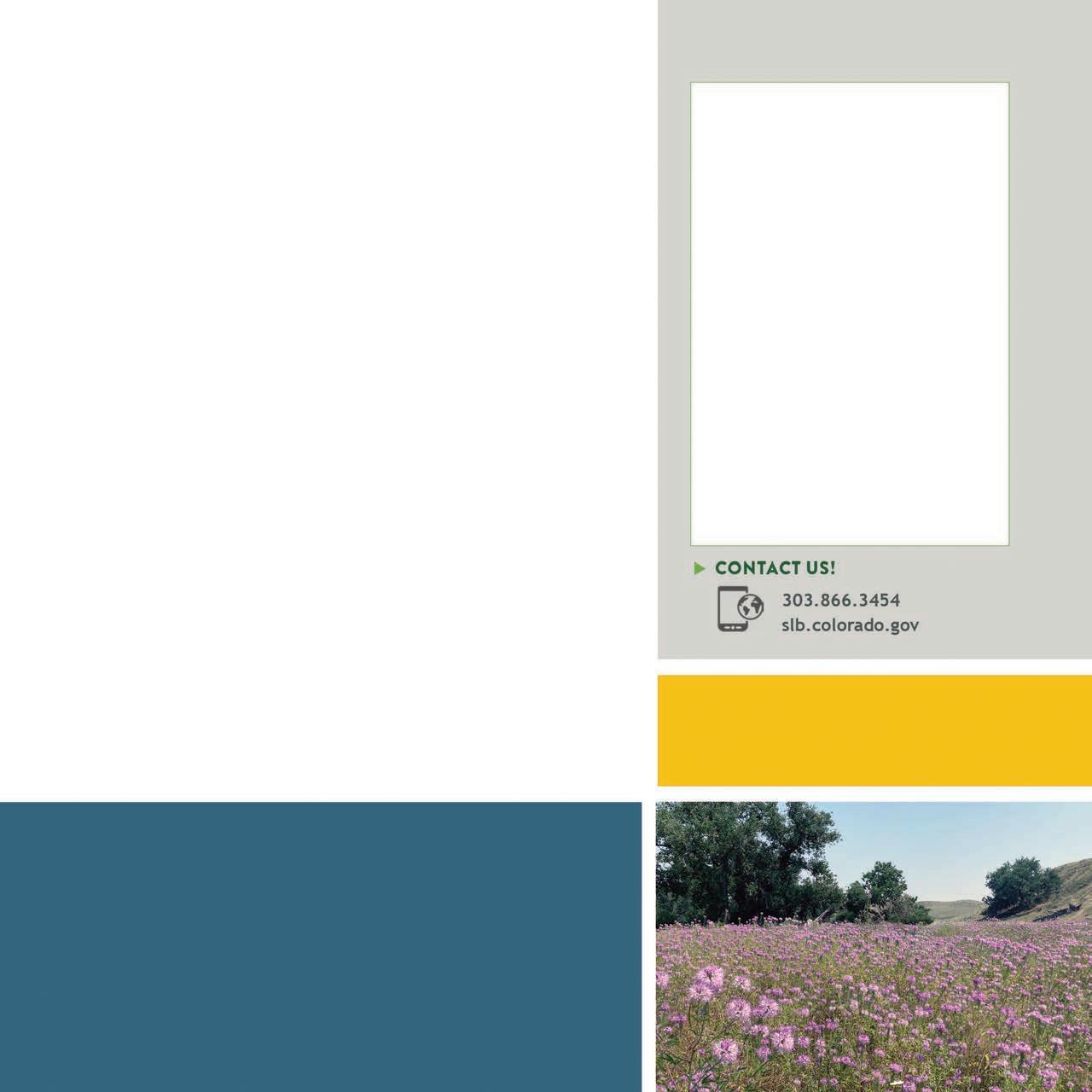
Greetings,
Congratulations! 2021-2022 set a new record in the State Land Board’s 146-year history. We earned $246.6 million for trust beneficiaries. This extraordinary figure exceeds the previous record, set in 2015, by sixteen percent.
Of this amount, 97 percent will support schoolchildren in Colorado, including $113.9 million in distributions to the Colorado Department of Education’s Building Excellent Schools Today (BEST) program. Our agency has distributed nearly $1 billion to the BEST program since the capital construction program’s inception in 2008.

While our financial success of fiscal year 2022 remains largely due to oil and gas development, we understand that oil and gas markets are volatile and that development in Colorado is projected to decline.
That’s why our intentional growth of recurring revenue streams is critical to fulfilling our long-term, intergenerational mission. We are planning for a future that relies less on carbon-based energy, and we aim to be leaders in the emerging carbon sequestration industry. I’m very pleased that our team followed through with our strategic initiatives to increase recurring, renewable revenue streams: we experienced a 13 percent growth in earnings from our surface leases, such as recreation, renewable energy, grazing, and ecosystem services.
This is made possible by our customers who pay us rent. I am grateful to our 7,460 lessees who have persevered while facing challenging business scenarios for the past several years. You are our partners in stewarding assets, and we appreciate your collaboration and flexibility during another year of challenging world events. Likewise, I extend my gratitude to our five Commissioners who volunteer their time to oversee the State Land Board. This year we welcomed three new Commissioners who brought fresh perspectives and invigorated our mission-focused work.
Together we will continue to support trust beneficiaries for generations to come.


Thank you, Bill Ryan, Director, State Land Board
The
Strategic
The School Trust
Financial overview
Revenue allocations
Trust distributions
We generated $246.6 Million in FY21-22
South Platte in Morgan County is a trust land property designated into the Stewardship Trust.
■
.......
■
.............
■
..................
■
...........................
■
....................
■
...
■
..............
■
...................
■
.................
■
................
■
..............
■
.................
■
................
Orchard
WHAT YOU WILL FIND IN THIS REPORT
Agency mission and history
5
Our impact on schools
6
Agency leadership
7
Contact us
8
Working with us
9
How revenue flows to schools
10
Stewarding the land
11
13
Permanent Fund Investment Board
14
15
16
17
Income Statement
18
FY21-22 ANNUAL REPORT
2026
Plan The Commissioners at the State Land Board are guided by the agency’s bold strategic plan that they adopted in 2019. It serves as our compass as we look ahead to our agency’s 150th anniversary in 2026. READ THE PLAN at slb.colorado.gov/about
FY21-22 ANNUAL REPORT
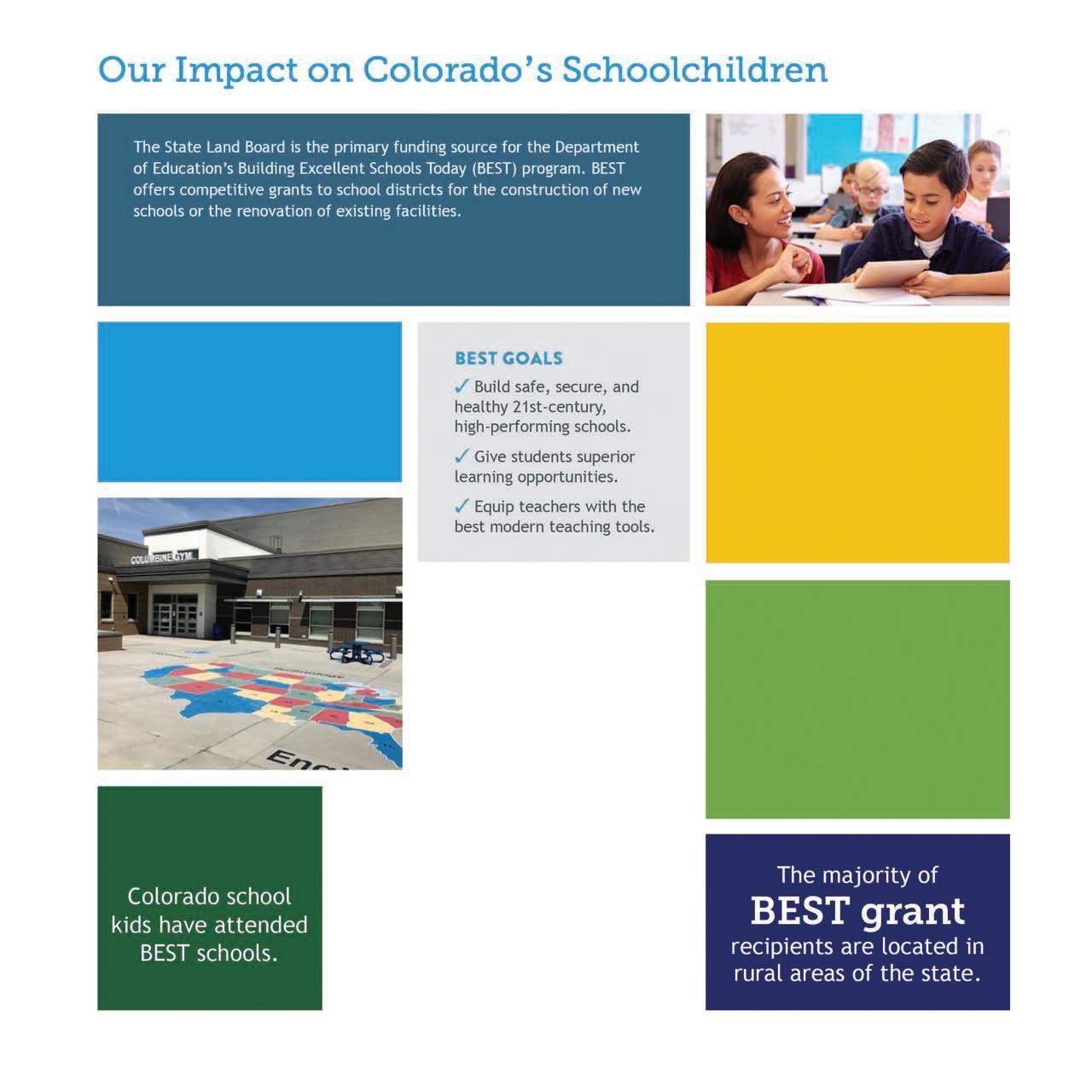
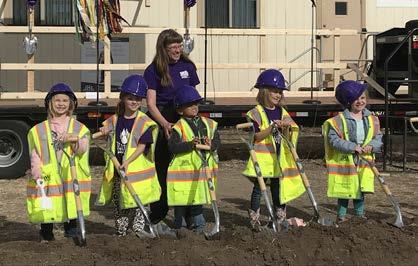


We contributed $113.9 million to BEST in FY21-22. We’ve contributed $976.5 million since the program began in 2008. Columbine Middle School in Montrose County previously received a $12.5 million BEST grant. More than 525 schools in Colorado have received a BEST grant. The Land Board contributed $113.9 million to BEST in FY21-22. 325,000 17.5 direct and indirect jobs (contractors, architects, materials suppliers, grocery stores, restaurants etc.) are created/ supported for every $1 million invested in BEST schools. Julesberg received a $33 million grant in 2021-22 and broke ground on its new preK-12 building in March. FY21-22 ANNUAL REPORT 6 FY21-22 ANNUAL REPORT 5
Leadership
Our agency is led by a Board of Commissioners. The Board is made up of five citizen volunteers, chosen by the Governor, and confirmed by the Colorado State Legislature. Commissioners are appointed to four-year terms and are limited to two consecutive terms. As fiduciaries, our Commissioners are responsible for prudently taking care of trust assets on behalf of beneficiaries, who are primarily Colorado schoolchildren.
Our agency was founded at statehood (1876). The Colorado Constitution requires that four of the five Commissioners have substantial experience in four separate areas: public K-12 education, production agriculture, local government, and natural resources. The fifth Commissioner serves as a citizen-at-large. The Commissioners do not represent the interest of a particular sector. Instead, they apply their industry experience when they make decisions on behalf of beneficiaries.
Commissioners are supported by 45 agency employees who are located in seven offices throughout the state.
Learn more about our leadership at slb.colorado.gov/leadership





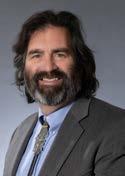
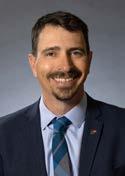

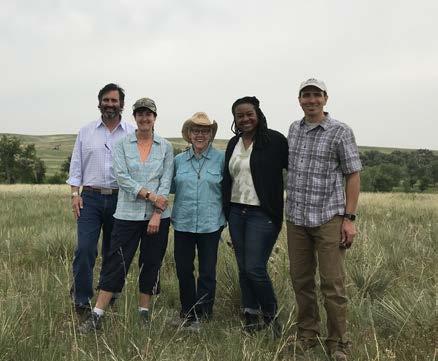

LINES OF BUSINESS
Agriculture 303.866.3454 x3325
Carbon Sequestration 303.86.3454 x3313 Commercial Leasing 303.866.3454 x3327 Ecosystem Services 303.866.3454 x3318 Mining 303.866.3454 x3313 Oil and Gas 303.866.3454 x3326 Recreation 303.866.3454 x3342
303.866.3454 x3327
x3328
x3328
Our FY21-22
Board of Commissioners
Five Commissioners tour Lowry Ranch in Arapahoe County in summer 2021.
Christine Scanlan Education Keystone Board President
Josie Heath Local Government Boulder
Scott Braden Natural Resources Grand Junction
Erin Clark Citizen-at-large Denver
Phillip Chavez Agriculture Rocky Ford
In 2022 the Commissioners and staff toured a fen on a Stewardship Trust property in Fairplay.
Commissioners have a fiduciary duty to make decisions in the best interest of trust beneficiaries.
RECEIVE OUR E-NEWSLETTER Stay in touch! Please contact us to sign up to receive our quarterly e-newsletter, Field Notes. View our past issues at slb.colorado.gov/newsletter FY21-22 ANNUAL REPORT FY21-22 ANNUAL REPORT
7 8
Renewable Energy
Rights-of-way 303.866.3454
Tower Sites 303.866.3454
Water 303.866.3454 x3325 LOCATIONS We have seven offices throughout the state. Alamosa | Southwest 719.589.2360 Denver | Main Office 303.866.3454 Eaton | North Central 970.454.5279 Lamar | Southeast 719.336.3031 Pueblo | South Central 719.543.7403 Steamboat Springs | Northwest 970.879.9992 Sterling | Northeast 970.522.0975
What We Do

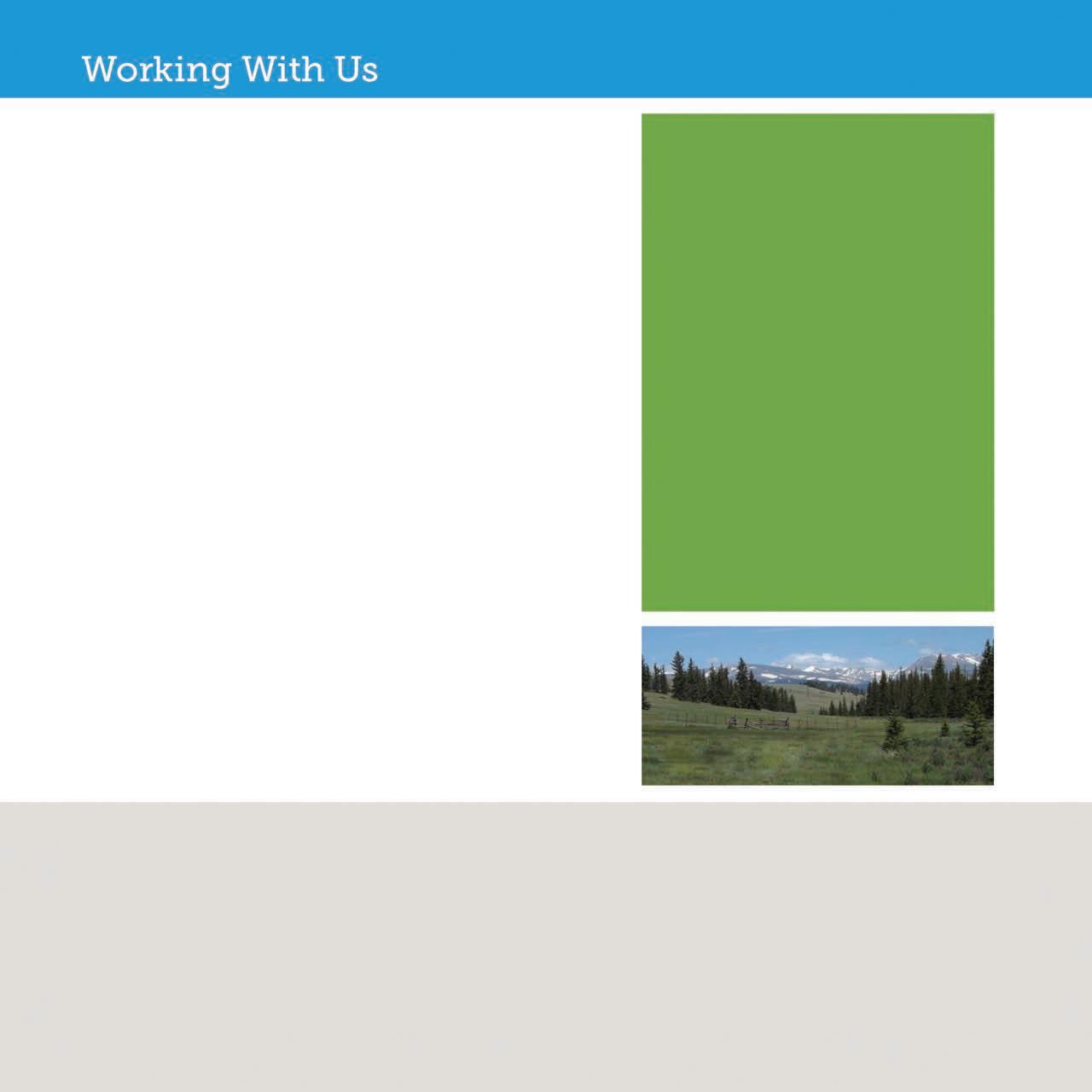
The State Land Board generates revenue for schoolchildren and other beneficiaries by leasing state-owned trust land and minerals. In FY21-22 we had 7,460 active leasing customers.
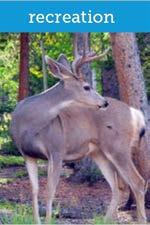

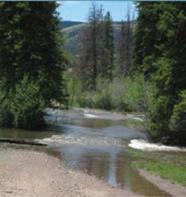

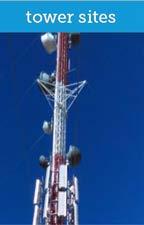


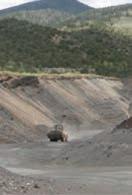
We are entrepreneurial in our pursuit of income. While our recent success remains largely due to extractive leases, such as oil and gas development, we are pushing ourselves to be innovative by increasing recurring revenues. The growth of recurring long-term revenue streams is critical to helping our agency fulfill our forward-looking, intergenerational mission. That’s why we have expanded renewable energy, recreation, ecosystem services, commercial real estate, and agriculture leasing. We welcome lease applications for new uses.


We also layer leases as a strategy to optimize revenue. For instance, one parcel of land might have a cattle grazing lease as well as a right-of-way lease for a power line. We ensure that customers with layered leases at a property work cooperatively with one another.

future opportunities Lines of Business ■ Agriculture (grazing, dry land crop production, and irrigated farming) ■ Carbon sequestration ■ Commercial real estate ■ Ecosystem serv ices (environmental mitigation of impacts on water, biodiversity, and carbon) ■ Mining (limestone, gypsum, coal, precious metals, and more) ■ Oil and gas ■ Recreation (hunting, fishing, hiking, horseback riding, and
■ Renewable energy (solar, wind, hydropower, geothermal, and biomass/bioenergy) ■ Rights-of-way ■ Tower sites ■ Water resources Magic Forest Fen (Stewardship Trust property) in Park County. agriculture/grazing agriculture/crop land commercial real estate ecosystem services mining oil and gas In FY22, we’re proud that ... ~ 97 percent of our income supported beneficiaries; we used only ~3 percent to fund our internal operations because we are self-funded and receive zero tax dollars. Your rent helped fund more than 525 schools in Colorado! Read more on page 6. Visit us at slb.colorado.gov carbon sequestration FY21-22 ANNUAL REPORT FY21-22 ANNUAL REPORT 9 10
more)
The State Land Board uses a variety of stewardship tools for the responsible management of trust land.
We use these tools individually or in tandem to identify and protect the important natural values and resources. Trust land is working land. The stewardship tools enable us to protect resources for the long-term benefit of beneficiaries while continuing to generate revenue in the short-term. Our Commissioners strive to find a balance between stewarding the land and earning income from it.
Multiple Tools to Enhance
■ STEWARDSHIP TRUST
Stewardship
A special management designation placed on 10 percent of lands with important natural values to preserve the long-term benefits of, and returns from, those assets to the trusts. The Stewardship Trust was created by Amendment 16 to the State Constitution.
■ COLORADO DESIGNATED NATURAL AREAS
A Colorado Parks and Wildlife (CPW) program that recognizes and monitors the state’s finest examples of biodiversity including rare plants and animals, unique geology, and paleontological features.
■ ASSET MANAGEMENT PLANS
A plan prepared by our agency for a specific state trust property (generally a large property asset of 25,000 acres or more).
■ STEWARDSHIP ACTION PLANS (SAPs)
A management plan prepared by our agency for a specific species or resource of concern on a landscape scale (i.e. greater sage grouse).
■ LEASE STIPULATIONS
Timing and surface use restrictions applied to leases with important natural or cultural resources. If the stipulations aren’t followed, the lessee is in violation of the lease terms and the lease is subject to termination.
■ GRAZING STRATEGIES
Grazing leases designed to reward lessees for utilizing certain stewardship practices, such as holistic grazing or flexible AUMs (animal unit months).
■ BEST MANAGEMENT PRACTICES (BMPs)
On-the-ground practices or procedures that lead to enhanced stewardship outcomes on state trust lands.
We define stewardship as: an ethic that embodies the responsible planning and management of resources.
296,617
number of acres in the Stewardship Trust
Amendment 16, Section 10
In 1996, the passage of Amendment 16 to the state Constitution by Colorado voters established a new emphasis in how our agency carries out our mission, particularly with regard to long-term productivity and sound stewardship of state trust lands. Amendment 16 specifically directed the Board to develop new tools that would promote sound stewardship and land management practices, long-term agricultural productivity, community stability, natural resource management practices, and conservation easements.
“As trustees of a perpetual trust, we should recognize and seek balance between the needs of today’s schoolchildren and the needs of the generations of children to come. Responsible stewardship of the land assets protects those assets and their value for both current and future generations of beneficiaries.”
— Mike Bloom, Former Commissioner (2007-2015), State Land Board
Important natural values include:
Read our complete Stewardship Report at slb.colorado.gov/stewardship
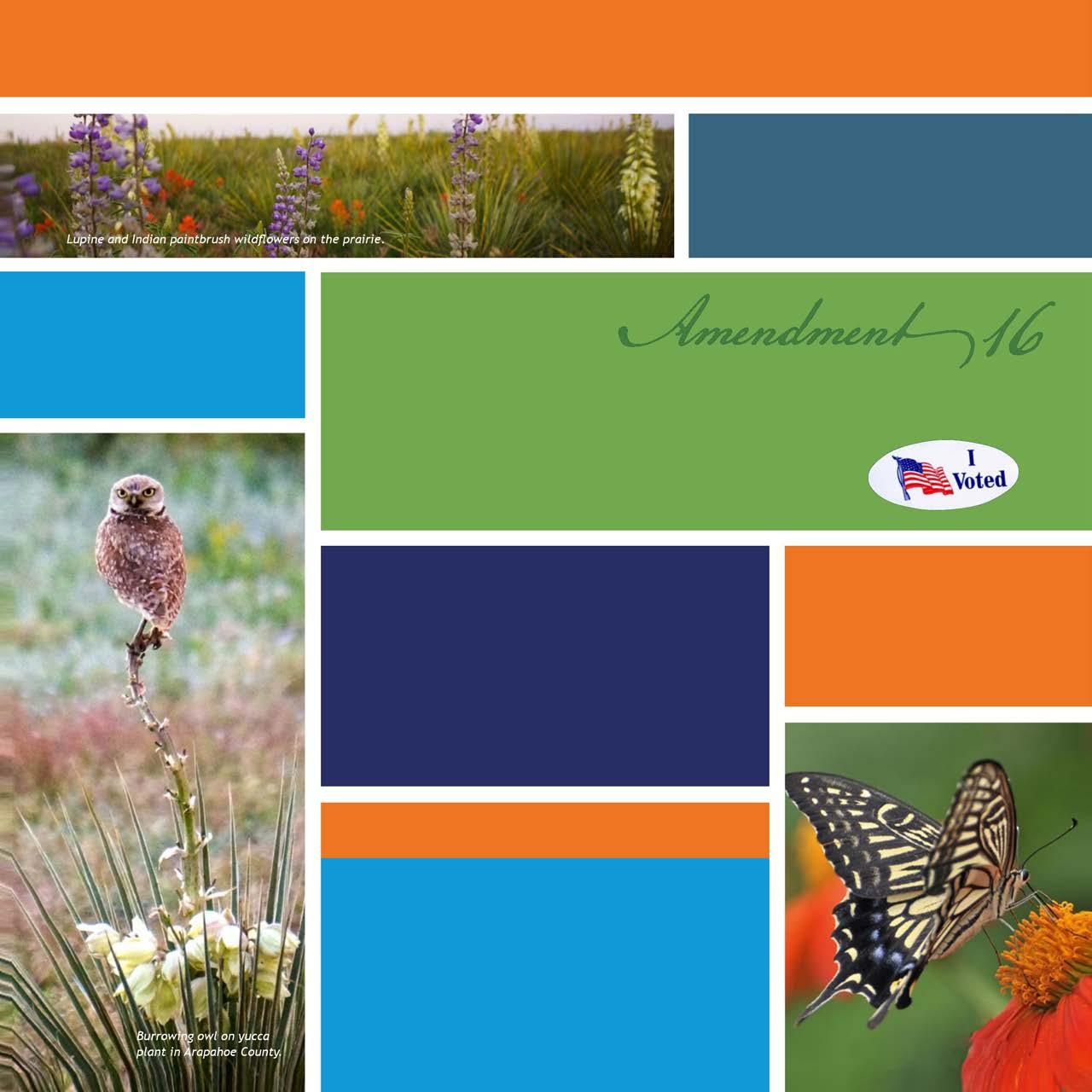
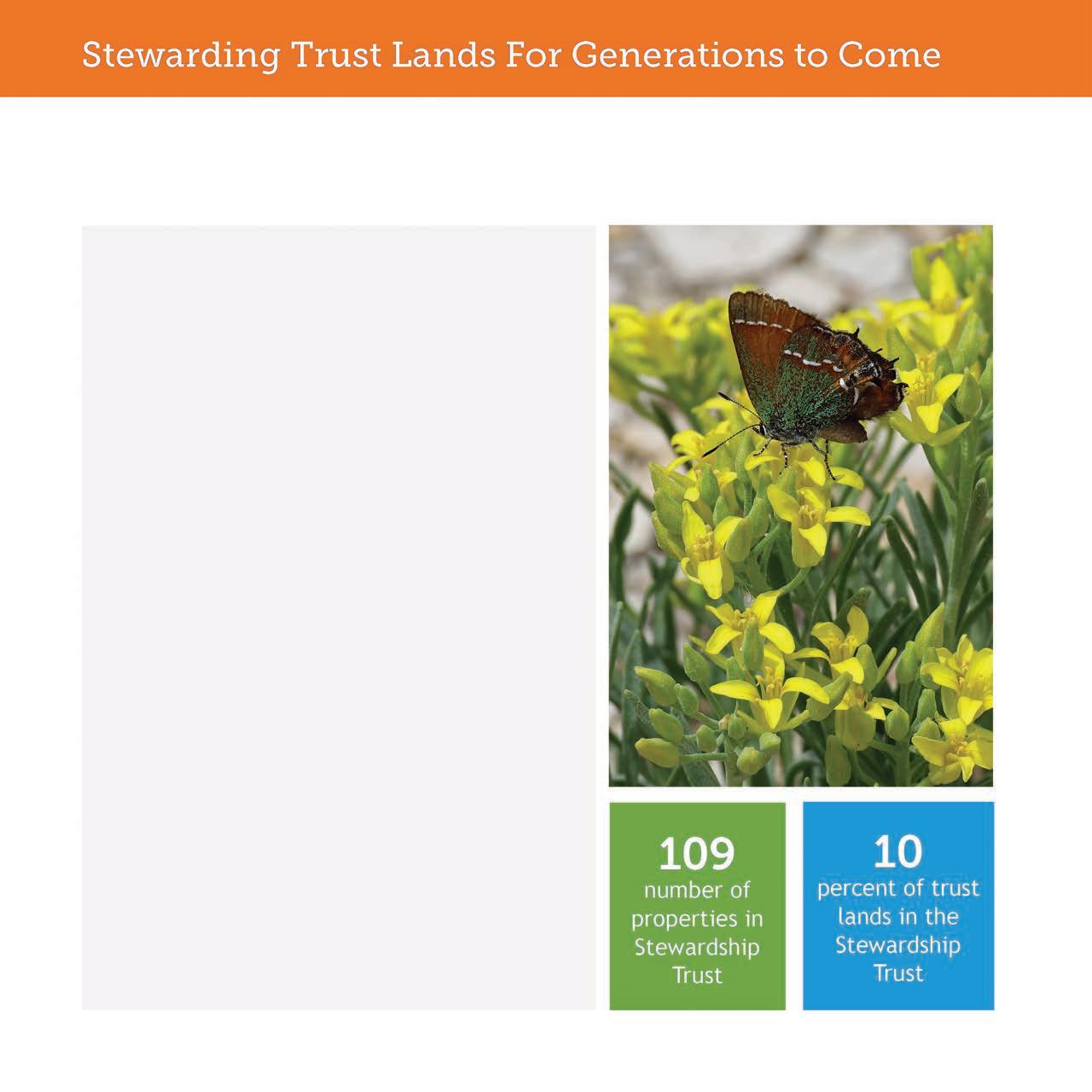
Rare plants and plant communities
Important wildlife habitat
Open space of landscape significance
Hydrologic features
Areas of biodiversity significance
Beauty
Cultural, paleontological, or unique geologic sites
Juniper hairstreak on Rocky Mountain bladderpod.
FY21-22 ANNUAL REPORT FY21-22 ANNUAL REPORT 11 12
The Colorado State Land Board manages trust assets that are valued at $4.2 billion. We earn income annually for beneficiaries by stewarding the assets that comprise the trust: land, water, minerals, pore space, commercial real estate, and the Permanent Fund.
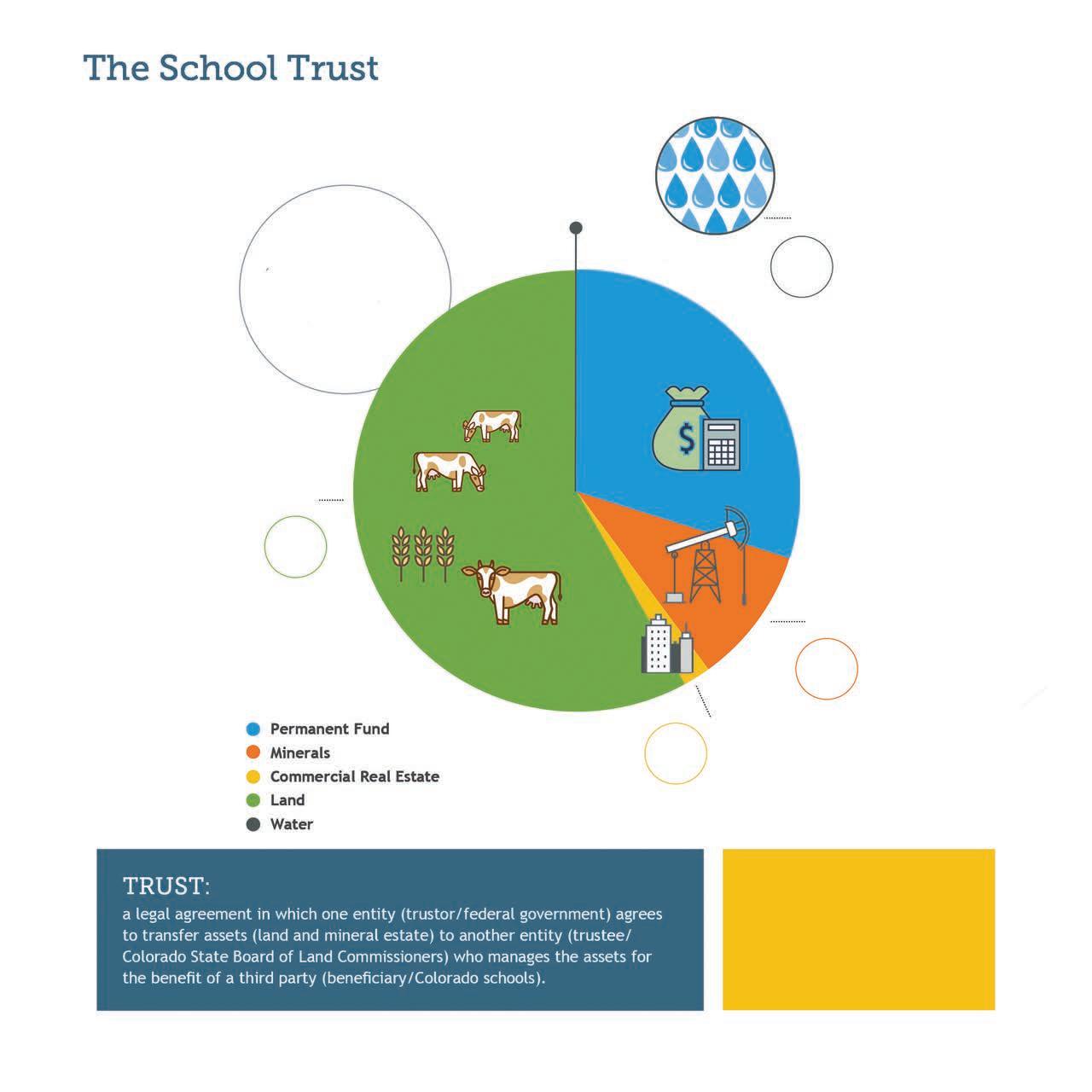
As of June 30, 2022, the Fund totaled $1.2 billion. This money is managed by the State Treasurer’s Office and the Permanent Fund Investment Board (PFIB). The corpus of the Permanent Fund is inviolate. The interest and earnings generated from the endowment are used to support beneficiaries (K-12 public schools) annually. The balance of the State Land Board’s annual revenue after BEST contributions and agency operations flows into the Permanent Fund.
The PFIB was created in 2016 to ensure reasonable growth of the endowment. The board directs the State Treasurer on how to securely invest the money for the intergenerational benefit of Colorado’s public schools. The board members work to preserve, protect, and grow the principal of the endowment with a prudent level of risk over a long-term horizon.
The PFIB works collaboratively with the Commissioners of the State Land Board. Per statute, the chair of the PFIB is the State Treasurer, and one member is a Commissioner from the State Land Board. The remaining three positions are filled by financial industry experts and are selected by the State Treasurer.

valued
$4.2 billion
(2022)
The trust is
at
$4.2 billion
In
the
It also authorizes the investment in more equities to add growth to the corpus to increase our yield. The
Permanent
endowment generated $33.9 million in interest in FY21-22. PERMANENT FUND INVESTMENT BOARD MEMBERS AS OF JUNE 30, 2022 <$1M 500M $2.4B 57% 57% 2% 12% <0.01 $100M ■ Dave Young Colorado State Treasurer (Board Chair) ■ Peter Calamari Platte River Equity ■ Wendy Dominguez Innovest Portfolio Solutions ■ Jerome DeHererra Achieve Law Group ■ Christine Scanlan Keystone Institute Lake County High School in Leadville, CO, previously received a BEST grant for its $26 million new facility.
The Public School Permanent Fund comprises the financial assets of the State Land Board’s trust.
spring 2022,
legislature passed House Bill 22-1146. The Bill authorizes the Treasurer and PFIB to create a working group to evaluate distribution models that will help optimize the trust in order to best serve today’s and future generations of beneficiaries.
$1.2 billion
Fund
FY21-22 ANNUAL REPORT FY21-22 ANNUAL REPORT 13 14
FY21-22 Trust Revenue Allocations
Colorado state trust assets generated $246.6 million in gross revenue in FY21-22. The net revenue flows to nine beneficiaries, primarily public schools. Of the nine beneficiaries, Colorado public schools received 99 percent of all revenue.
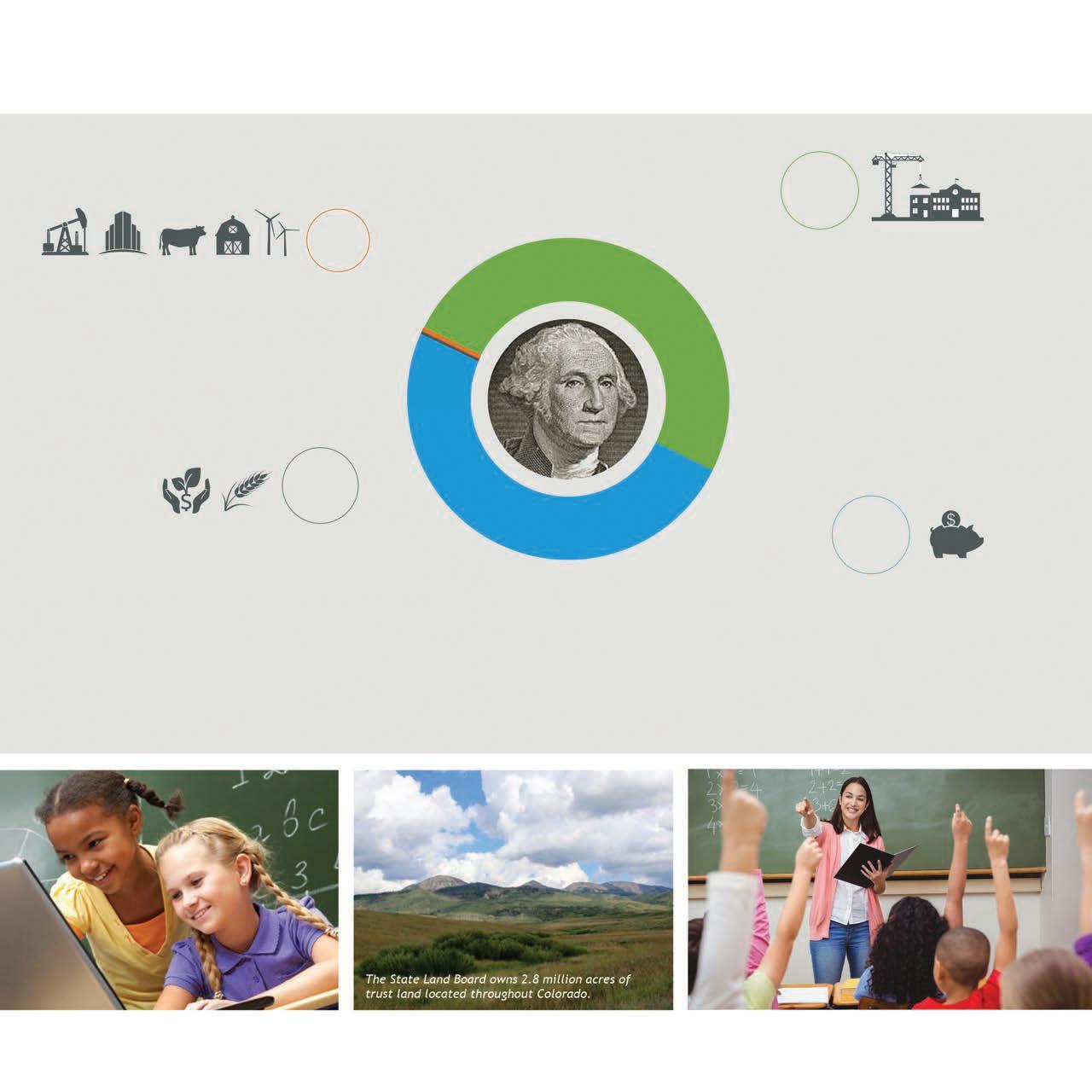
Oil and gas markets continue to be unpredictable. Wide swings in market prices this year resulted in a record-setting $175.8 million in mineral extraction revenues. Despite periods of high prices, overal volumes of petroleum production were relatively steady in FY21-22. The long-term forecast for oil and gas markets in Colorado continues to predict a decline. The volatility of these markets underscores our agency’s strategic efforts to diversity our revenue streams.
In FY21-22 we experienced a 13 percent growth in earnings from our surface leases, such as recreation, renewable energy, grazing, and ecosystem services.
CAPITAL CONSTRUCTION FOR COLORADO’S PUBLIC SCHOOLS
MESSAGE FROM
“The data presented in this annual report have been prepared in accordance with generally accepted government accounting standards by the hardworking staff of the Colorado State Land Board and the Office of the Treasurer. This report accurately represents the activity of the trust assets during fiscal year 2022.”
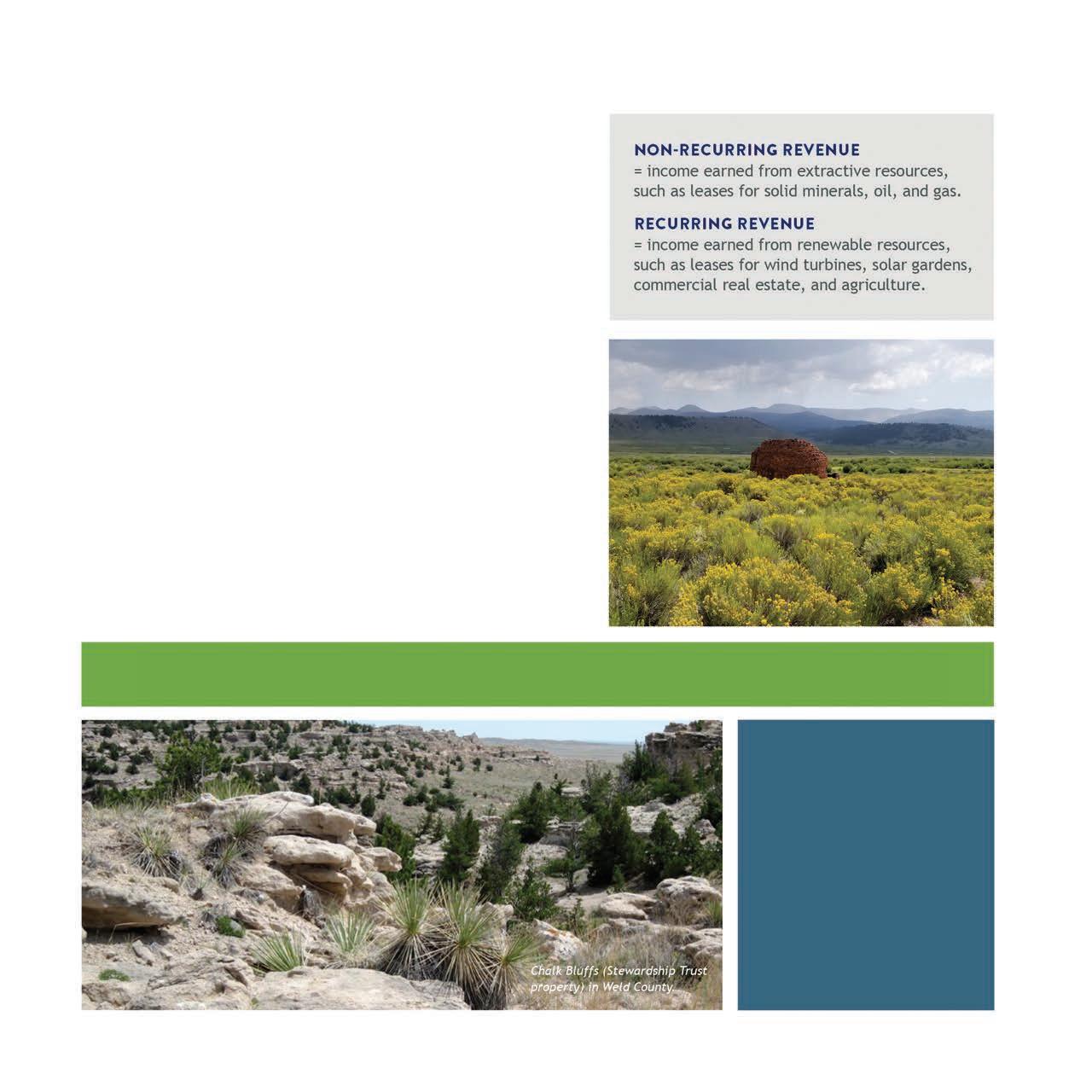
AGENCY OPERATIONS
The State Land Board is a self-funded state agency. We receive no taxpayer dollars. Rather, money for our operations comes entirely from trust gross revenues. The State Land Board employed 45 people and had $7.4 million in operating expenses in FY21-22.
3% ~1%
INVESTMENT AND DEVELOPMENT FUND
Per statute, the I&D Fund allows the agency to invest up to $5 million per year of School Trust revenue back into School Trust assets in order to increase or maintain the value and/or income of these assets for the trust. In FY21-22 we spent $1,529,727 on trust asset improvements from this fund.
Fifty percent of our revenue flowed directly to the Colorado Department of Education’s Building Excellent Schools Today (BEST) program. We distributed $102 million in leasing revenue to BEST and BEST also received $11.7 million in Permanent Fund interest spillover earnings. The total distributed to BEST from State Land Board assets in FY22 was $113.9 million.
See page 6 for a description of BEST.
50% 47%
Every year, the balance of revenue after BEST contributions and agency operations flows to the Public School Permanent Fund (Permanent Fund). We deposited $89.9 million into the fund in FY21-22, which brought the year-end balance to $1.2 billion. This endowment fund is managed by the State Treasurer’s Office. The body of the Permanent Fund is inviolate; the interest it generates is used to support K-12 education annually. In FY21-22 the Permanent Fund generated $33.9 million in interest. Read more on page 14.
FY21-22 Financial Overview
Crystal Lake property (designated into the Stewardship Trust) in Lake County.
OUR CFO
— Nick Massie, CFO-COO, Colorado State Land Board
The State Land Board grossed $246.6 million in FY 21-22
PUBLIC SCHOOL PERMANENT FUND
VIEW OUR COMPLETE INCOME AND INVESTMENT REPORT AT slb.colorado.gov/reports FY21-22 ANNUAL REPORT FY21-22 ANNUAL REPORT 15 16
Trust Beneficiaries
The State Land Board oversees nine trusts on behalf of trust beneficiaries.
The concept of reserving land to be held in a trust and used for public beneficiaries dates to the founding of our country. America’s founding fathers believed that funding public institutions to support citizens would help ensure a stable democracy.
They were also preparing for westward expansion at the conclusion of the Revolutionary War. In the 1780s Thomas Jefferson developed a system -- today often referred to as the Jeffersonian Grid -- to orderly track and divide land into 36-square-mile townships/ranges/sections. Each state that joined the Union after the war received a certain number of one-square-mile sections to be held in trust for different public beneficiaries, such as hospitals, penitentiaries, schools, or institutions of higher learning. The leaders of each territory and the federal government negotiated the terms at
the time of statehood.
When the territory of Colorado joined the Union in 1876, we received two sections per township to be held in trust for nine beneficiary groups. By far the largest is the School Trust, which reflects 99 percent of the total assets our agency manages. The School Trust supports all public schools in the state.

The remaining one percent supports eight other beneficiary groups: Colorado State University, government buildings (via the Department of Personnel Administration), Fort Lewis College, penitentiaries (via the Department of Corrections), University of Colorado, state parks (via Colorado Parks and Wildlife) and the State Forest (via the State Forest State Park). Fort Lewis College and the Department of Corrections hold Beneficiary Use Agreements so that they can self-manage the day-to-day operations on their parcels. Read more about trust beneficiaries at slb.colorado.gov/beneficiaries
MINERALS
$56,046,618 $86,794,449 $86,333,908 $51,068,425 $107,225,572
$25,154,539 $26,288,944 $21,330,091 $29,561,944 $58,021,743
$1,296,410 $1,246,924 $1,231,458 $939,304 $1,010,763
(coal,limestone,sand, $5,689,805 $7,589,570 $2,717,077 $5,177,875 $6,218,781
$15,343,624 $3,246,400 $1,526,110 $1,860,023 $3,321,207 Total

$103,530,996 $125,166,287 $113,138,645 $88,607,572 $175,798,067 SURFACE
$3,866,369 $3,370,571 $3,394,324 $3,270,526 $3,523,737
$8,826,661 $8,885,800 $9,482,946 $9,672,688 $10,748,124
$1,951,707 $1,973,781 $2,265,773 $2,463,223 $3,126,708
$2,833,525 $1,535,169 $2,464,619 $1,710,394 $3,323,482
$3,634,759 $5,558,956 $2,543,331 $2,781,768 $9,623,961
$21,324,277 $20,150,993 $19,898,599 $30,346,013
$1,890,000
$1,710,201
$359,828 $414,722 $443,826 $381,318 $503,867
$1,657,523 $1,893,981 $2,901,976 $2,360,458
FY21-22 REVENUES
$212,608,607
OF TOTAL
TRUST FY21-22 Gross lease revenue for trust beneficiaries
Trust Internal Improvements Trust CSU Trust
CU Trust Public
TrustTrust
Trust
Trust
Trust
$210,935,818 $720,053 $742,554 $68,301 $35,446 $38,099 $46,294 $22,042 $0
%
99.21% 0.34% 0.35% 0.03% 0.02% 0.02% 0.02% 0.01% 0.00% 100.00% BENEFICIARY
School
Common Schools
Buildings
Saline
Forest Penitentiary
Hesperus
Common Schools Colorado Parks and Wildlife Colorado State University University of Colorado Public Buildings State Parks Multiple Colorado Department of Corrections Fort Lewis College Total Trust Revenues
REVENUE FY17-18 FY18-19 FY19-20 FY20-21 FY21-22
Oil Royalties
Gas Royalties
and Gas Rentals
Oil
Royalties
Rentals
Bonus
Mineral Revenue
Solid
and
Rental
Agricultural
Grazing Rental
Recreation
Right of Way
Other `
Total Surface Revenue $21,113,021
COMMERCIAL Buildings (Net)
Ground Lease (cell, etc.)
Tower Sites
Renewable Energy
Total Commercial Revenue $7,178,730
Total Trust Gross Revenue $131,822,748
Non-Trust Fee Revenue $140,435 $130,759 $104,429 $110,115 $95,847 Total Agency Revenue $131,963,183 $152,077,414 $140,388,218 $117,528,402 $212,704,454 Operating Expenses $6,971,524 $7,589,975 $7,167,520 $6,622,542 $7,443,405 Net Operating Income $124,991,659 $144,487,439 $133,220,698 $110,905,860 $205,261,049 Permanent Fund Interest * $25,536,748 $29,597,290 $30,955,697 $31,171,603 $33,891,255 Total Income $150,528,407 $174,084,729 $164,176,395 $142,077,463 $239,152,304 5-Year Cumulative $870,019,298 This statement reflects prior period adjustments. ` Other income from ecosystem services, Conservation Reserve Program (CRP), homesites, subleasing, surface assignments, surface use agreements, and temporary access permits. Also income from fees and penalties; interest from funds held on account; and expired land disposals. * This trust asset is managed by the State Treasurer. Annual Income Statement for All Trusts (Cash Basis) FY21-22 ANNUAL REPORT FY21-22 ANNUAL REPORT 17 18
$3,930,976 $2,243,223 $3,085,000 $4,000,208
$1,095,940 $1,140,622 $1,571,344 $1,628,614
$1,791,986
$5,456,091 $6,994,151 $8,912,116 $6,464,527
$151,946,655 $140,283,789 $117,418,287 $212,608,607
The Colorado State Land Board staff and Commissioners appreciate your partnership and welcome your continued feedback. Visit us at one of our seven offices throughout the state. Or join us in person or virtually at one of our monthly board meetings. Our meetings are live-streamed, and we hold our meetings in alternating locations throughout the state to make it easier for citizens from all areas of Colorado to attend. Learn more at slb.colorado.gov/public-meetings
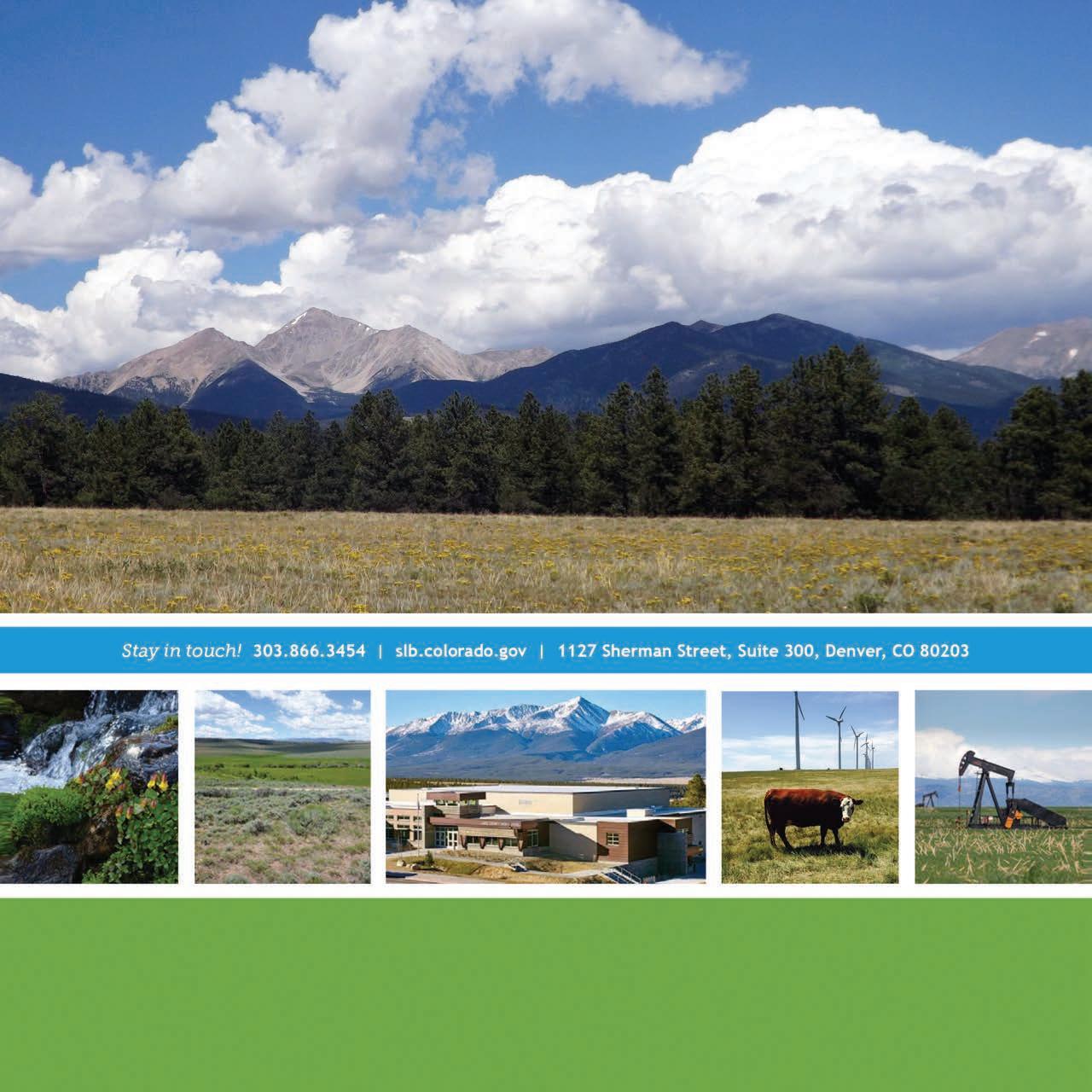 Mt.Princeton/Maxwell Park trust land property in Chaffee County.
Mt.Princeton/Maxwell Park trust land property in Chaffee County.










































 Mt.Princeton/Maxwell Park trust land property in Chaffee County.
Mt.Princeton/Maxwell Park trust land property in Chaffee County.